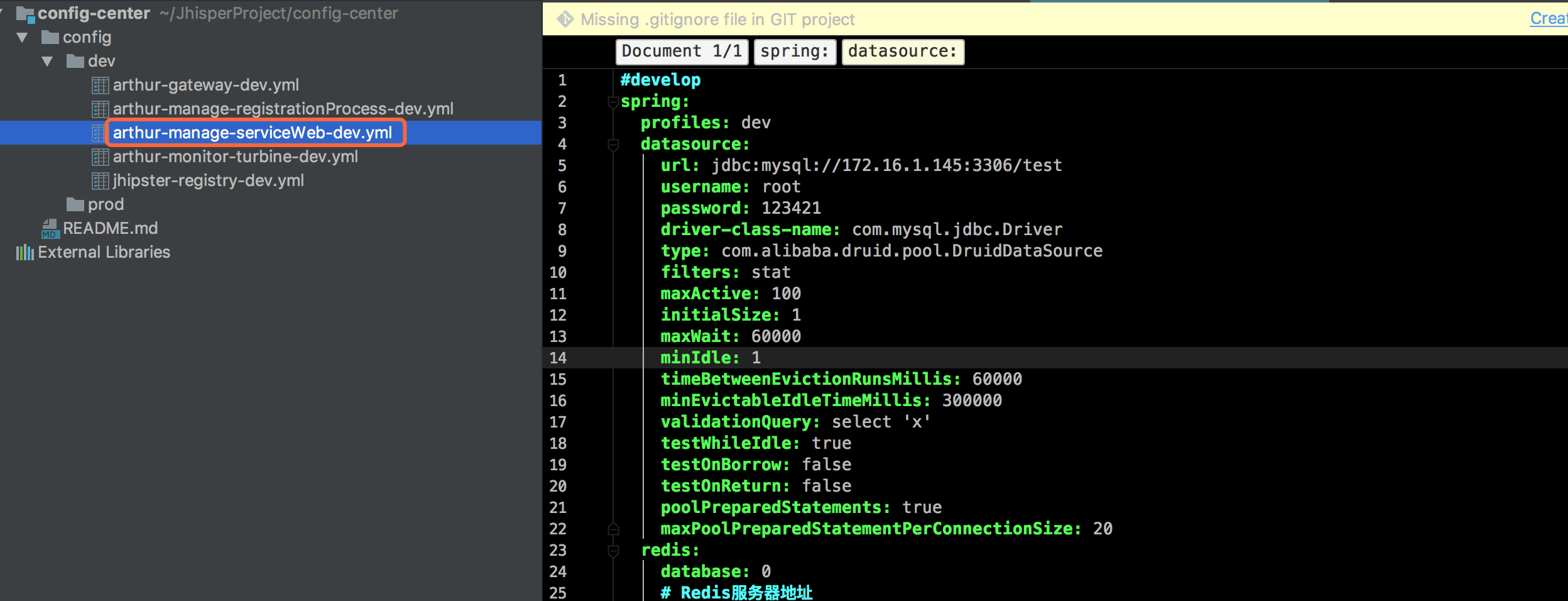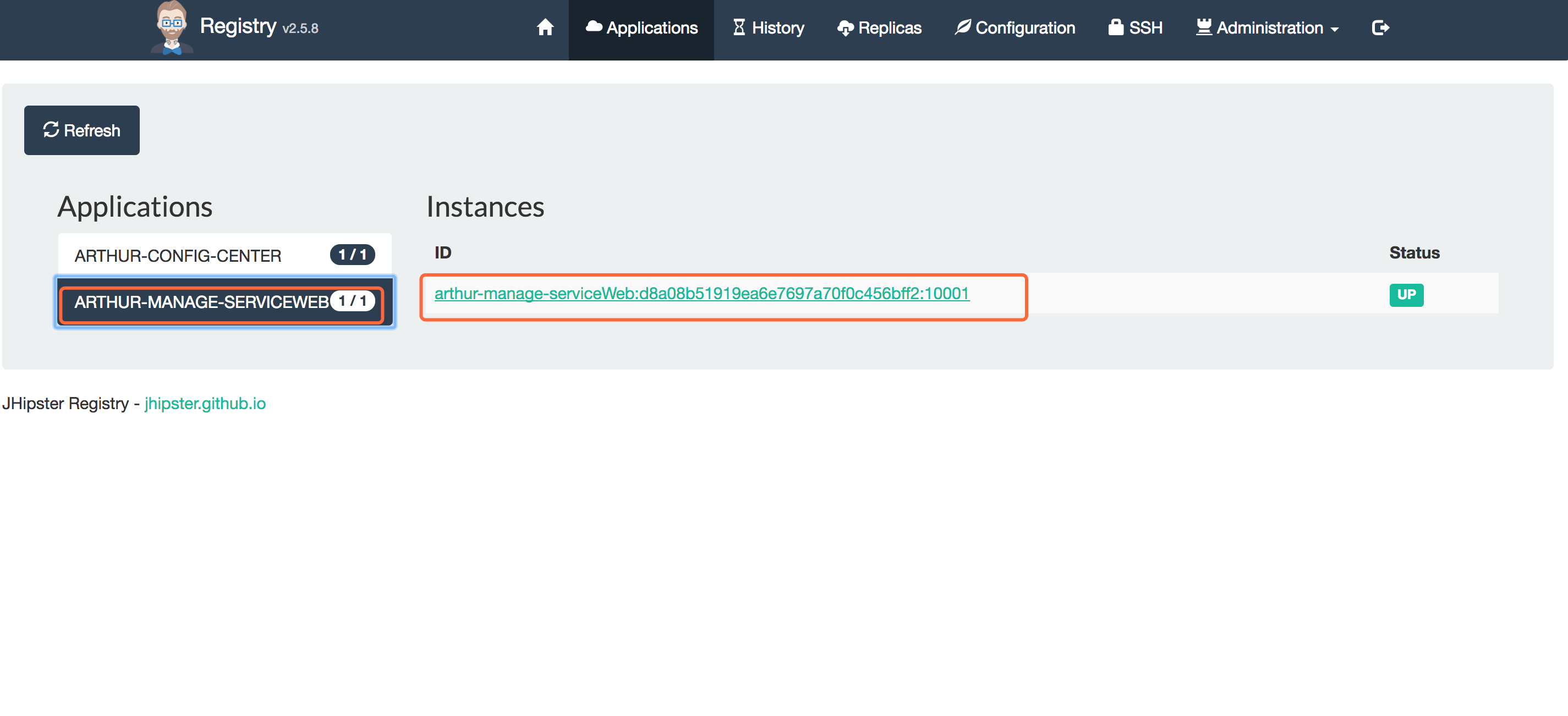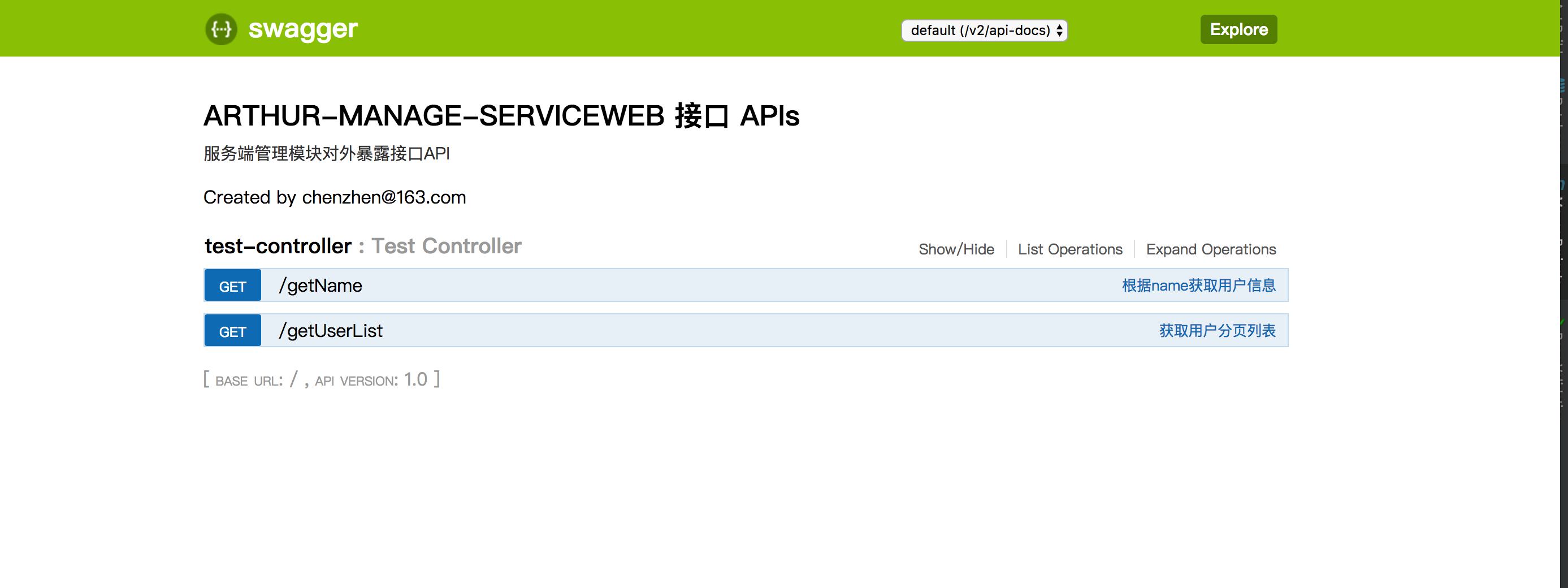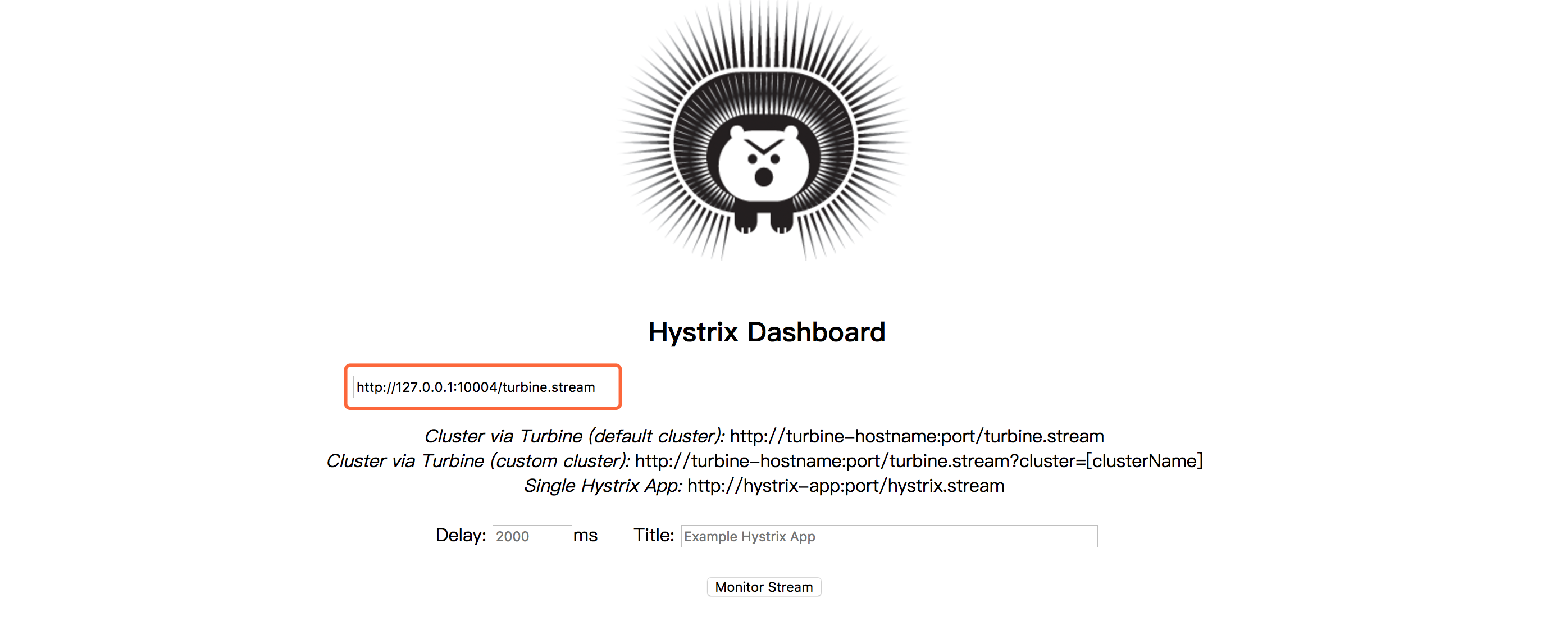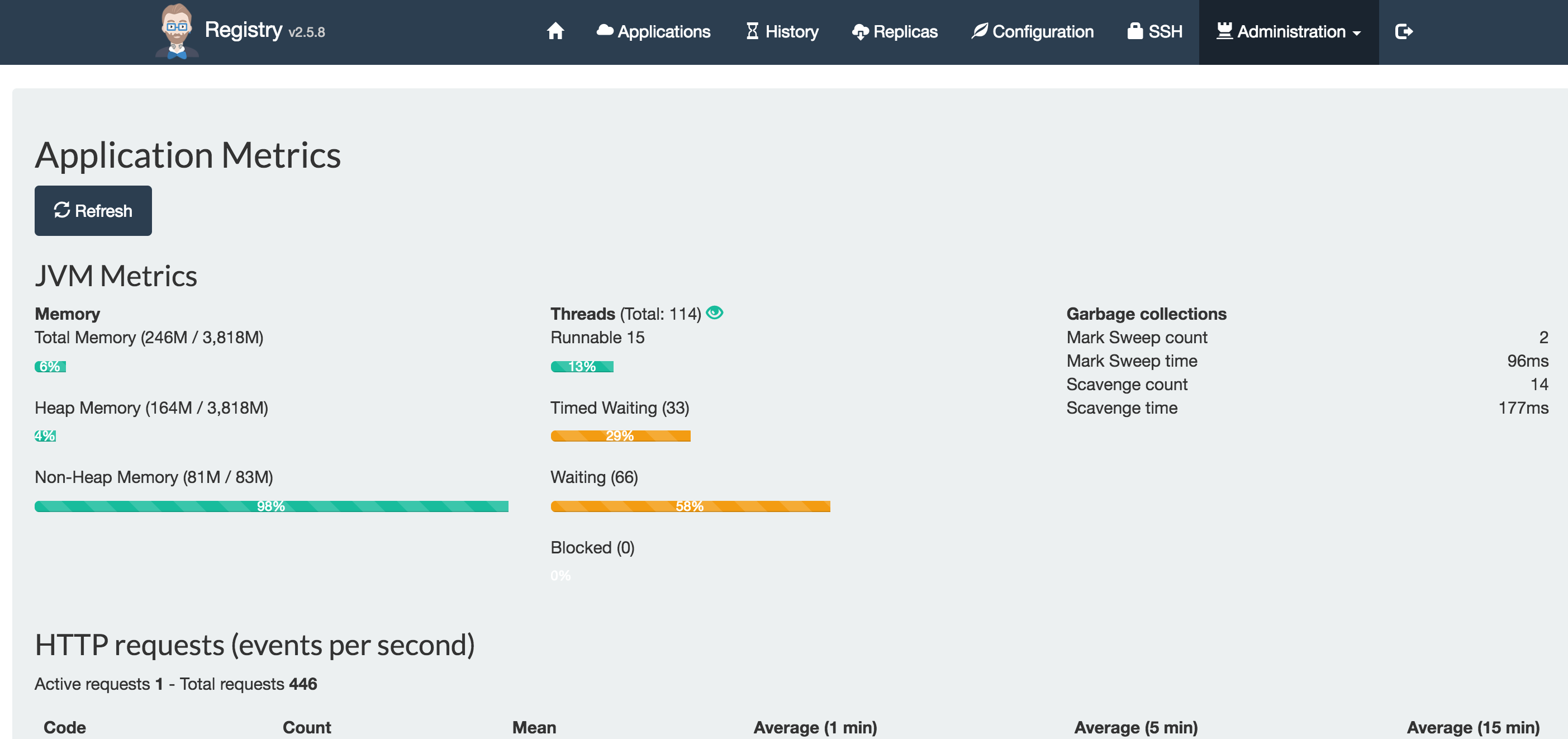springboot构建spring cloud 微服务项目 搭建ARTHUR框架分享
2017-08-17 16:57
961 查看
在此分享下本人最近搭建的一个springcloud微服务项目,包括注册中心、配置中心、熔断器、turbine熔断器集中监控中心、fegin、前后端负载均衡、swagger2、网关bus动态修改配置等等。项目只是初步搭建,之后还会加入各种好玩的技术,会不定期更新,感兴趣的可下载进行研究交流,微服务的明天会更好。
github
arthur https://github.com/ArthurFamily/arthur.git config https://github.com/ArthurFamily/config-center.git
码云 https://git.oschina.net/ArthurFamily/arthur.git https://git.oschina.net/ArthurFamily/config-center.git
(注:配置文件通过git项目读取,放到一个项目中读取超过5分钟才会有响应,经测试不是网络原因,配置文件单独放置一个项目没有问题。)
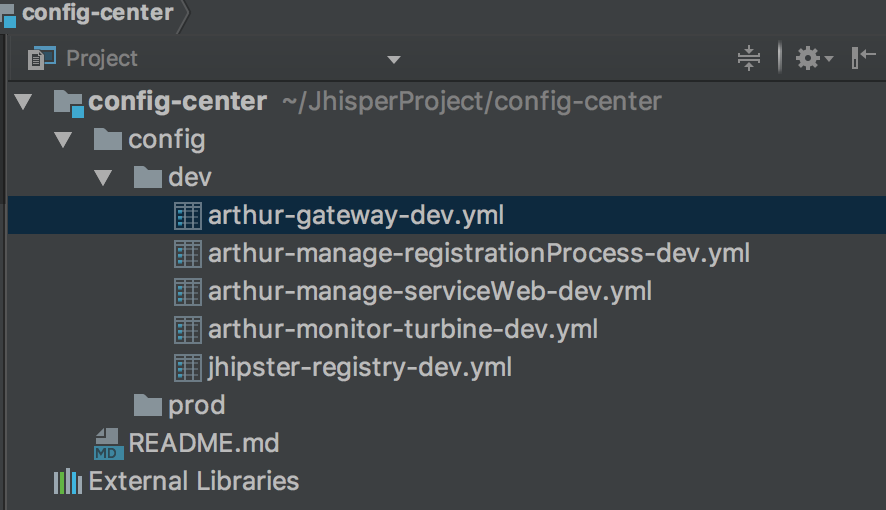
最后两个模块主要做模块间通讯测试,没有页面,只是简单的连接了数据库,页面之后会增加。
注册中心eureka主要使用的Jhipster的jhipster-registry-2.6.0版本,最新的版本3.1.0启动异常,貌似是zuul的问题,故采用稳定版,页面比原生的eureka页面要美观一些Jhipster抽空还会介绍,可以生成微服务项目,但是前端采用的angularjs,还在入门,故想集成bootstrap框架,所以子项目自己搭建,只用它的注册中心。如果需要搭建高可用集群注册中心,可部署多台eureka进行以来注册,也就是通常说的服务端的负载均衡。
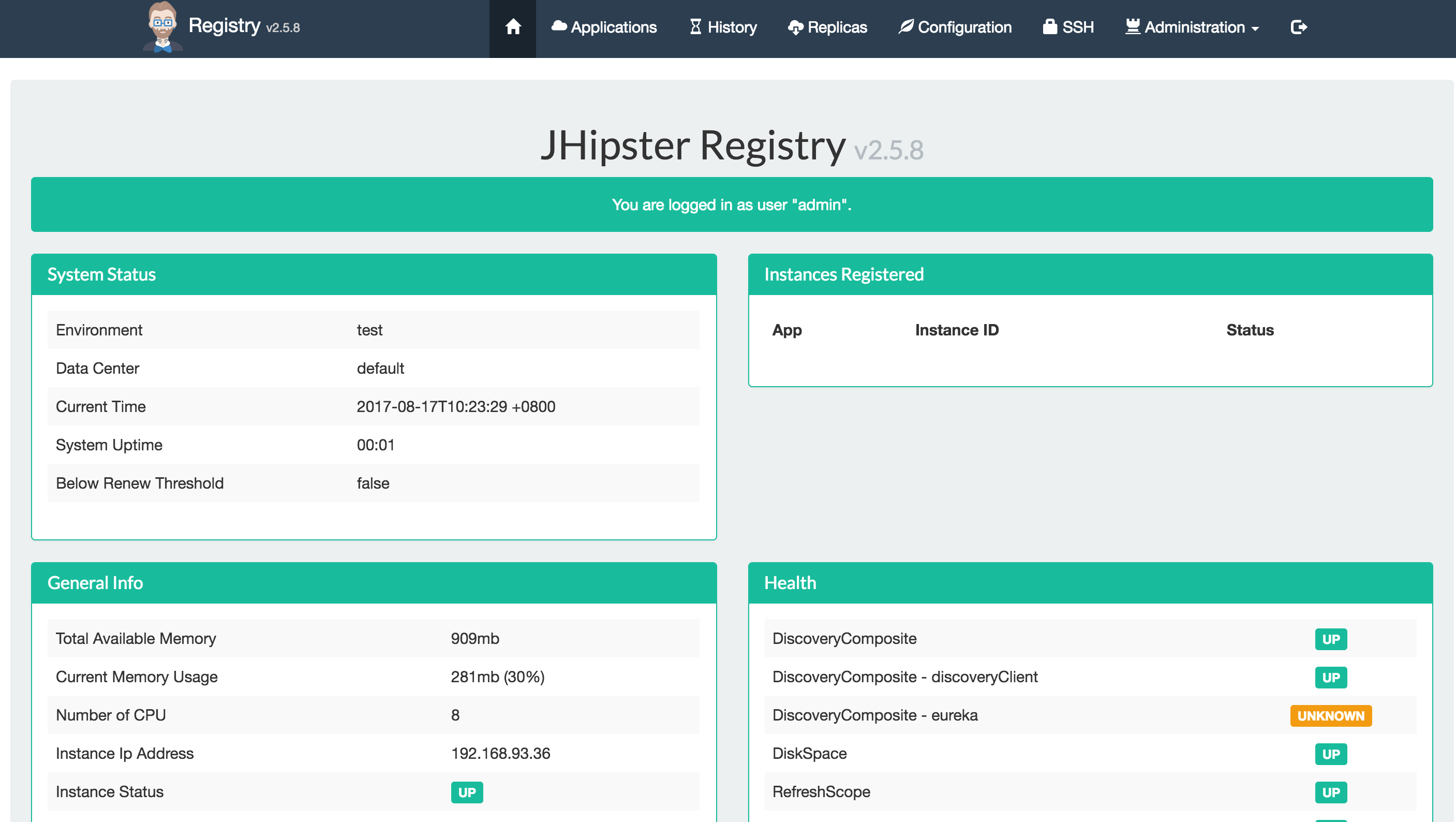
1.首先介绍下配置中心 arthur-config-center,需要引入spring-cloud-config-server
加入EnableConfigServer注解
进行注册,这里采用的高可用配置中心,可部署多台应用,然后依赖的项目跟进注册中心的服务名去读取各自的配置文件
github
arthur https://github.com/ArthurFamily/arthur.git config https://github.com/ArthurFamily/config-center.git
码云 https://git.oschina.net/ArthurFamily/arthur.git https://git.oschina.net/ArthurFamily/config-center.git
(注:配置文件通过git项目读取,放到一个项目中读取超过5分钟才会有响应,经测试不是网络原因,配置文件单独放置一个项目没有问题。)
<modules> <!-- 注册中心与配置中心使用jhipster2.6.0 --> <module>arthur-eureka</module> <!-- 配置中心 --> <module>arthur-config-center</module> <!-- 集中监控断路器仪表盘 --> <module>arthur-monitor-turbine</module> <!-- zuul网关 --> <module>arthur-gateway</module> <!-- 后台管理之服务网管理 --> <module>arthur-manage-serviceWeb</module> <!-- 注册流程 --> <module>arthur-manage-registrationProcess</module> </modules>

最后两个模块主要做模块间通讯测试,没有页面,只是简单的连接了数据库,页面之后会增加。
注册中心eureka主要使用的Jhipster的jhipster-registry-2.6.0版本,最新的版本3.1.0启动异常,貌似是zuul的问题,故采用稳定版,页面比原生的eureka页面要美观一些Jhipster抽空还会介绍,可以生成微服务项目,但是前端采用的angularjs,还在入门,故想集成bootstrap框架,所以子项目自己搭建,只用它的注册中心。如果需要搭建高可用集群注册中心,可部署多台eureka进行以来注册,也就是通常说的服务端的负载均衡。

1.首先介绍下配置中心 arthur-config-center,需要引入spring-cloud-config-server
<dependencies>
<dependency>
<groupId>org.springframework.cloud</groupId>
<artifactId>spring-cloud-config-server</artifactId>
<version>${springcloudconfig-version}</version>
<exclusions>
<exclusion>
<artifactId>slf4j-api</artifactId>
<groupId>org.slf4j</groupId>
</exclusion>
</exclusions>
</dependency>
<dependency>
<groupId>org.springframework.boot</groupId>
<artifactId>spring-boot-starter-logging</artifactId>
</dependency>
</dependencies>加入EnableConfigServer注解
@SpringBootApplication
@EnableConfigServer
@EnableDiscoveryClient
public class ConfigCenter {
private static final Logger LOG = LoggerFactory.getLogger(ConfigCenter.class.getName());
public static void main(String[] args) throws UnknownHostException {
SpringApplication app = new SpringApplication(ConfigCenter.class);
//DefaultProfileUtil.addDefaultProfile(app);
Environment env = app.run(args).getEnvironment();
LOG.info("\n----------------------------------------------------------\n\t" +
"Application '{}' is running! Access URLs:\n\t" +
"Local: \t\thttp://127.0.0.1:{} \n\t" +
"External: \thttp://{}:{} \n\t" +
"Profile(s): \t{}\n----------------------------------------------------------",
env.getProperty("spring.application.name")+"("+env.getProperty("version")+")",
env.getProperty("server.port"),
InetAddress.getLocalHost().getHostAddress(),
env.getProperty("server.port"),
env.getProperty("spring.profiles.active"));
}
}进行注册,这里采用的高可用配置中心,可部署多台应用,然后依赖的项目跟进注册中心的服务名去读取各自的配置文件
# 注册中心 eureka: client: enabled: true #注册中心开启健康检查会刷新上下文 healthcheck: enabled: false fetch-registry: true register-with-eureka: true instance-info-replication-interval-seconds: 10 registry-fetch-interval-seconds: 10 serviceUrl: defaultZone: http://${eurekaCenter.username}:${eurekaCenter.pasword}@localhost:8761/eureka/[/code] 配置Git#配置中心 GitHub配置 cloud: config: server: git: uri: https://github.com/ArthurFamily/config-center.git search-paths: /config/dev strict-host-key-checking: false
启动后访问http://127.0.0.1:10002/arthur-manage-serviceWeb/dev,返回配置文件json, 这里有一个对应规则,对应配置文件中的{服务名-dev(profiles->active的名)},配置文件中放置数据库、redis等配置
2.微服务项目 arthur-manage-serviceWeb 包括mybatis分页插件,自动配置数据源,与arthur-manage-registration 通过fegin进行接口调用,swagger2,ribbon的使用等。<dependencies> <!-- 自动配置,引入后,配置文件里必须配置,用到再引入故不在父级放置 --> <dependency> <groupId>org.mybatis.spring.boot</groupId> <artifactId>mybatis-spring-boot-starter</artifactId> <version>${springboot-mybatis}</version> <exclusions> <exclusion> <artifactId>spring-boot</artifactId> <groupId>org.springframework.boot</groupId> </exclusion> </exclusions> </dependency> <dependency> <groupId>org.springframework.boot</groupId> <artifactId>spring-boot-starter-data-redis</artifactId> </dependency> <!-- 数据库分页插件 --> <dependency> <groupId>com.github.pagehelper</groupId> <artifactId>pagehelper-spring-boot-starter</artifactId> <version>LATEST</version> </dependency> </dependencies>
公用的都在父级pom,部分如下fegin、hystrix、服务注册发现的、读取config的等<!-- fegin 自带断路器--> <dependency> <groupId>org.springframework.cloud</groupId> <artifactId>spring-cloud-starter-feign</artifactId> </dependency> <!-- 断路器 --> <dependency> <groupId>org.springframework.cloud</groupId> <artifactId>spring-cloud-starter-hystrix</artifactId> </dependency> <dependency> <groupId>org.springframework.cloud</groupId> <artifactId>spring-cloud-starter-eureka</artifactId> <version>${eureka-version}</version> </dependency> <dependency> <groupId>org.springframework.cloud</groupId> <artifactId>spring-cloud-starter-config</artifactId> <version>${springcloudconfig-version}</version> <exclusions> <exclusion> <artifactId>spring-boot</artifactId> <groupId>org.springframework.boot</groupId> </exclusion> </exclusions> </dependency>
mybatis-spring-boot-starter会自动读取配置文件中的数据源配置,无需我们自己去实现创建datasource、sqlsessionfactory等spring: application: name: arthur-manage-serviceWeb profiles: active: dev output: ansi: enabled: ALWAYS jackson: default-property-inclusion: non_null cloud: config: discovery: enabled: true service-id: arthur-config-center
注意@MapperScan扫描mapper接口,原生的baseMapper不能被扫描到,故自己创建,扫描mapper配置文件在application.yml中# mybatis mapper 文件 mybatis: mapper-locations: classpath:mapper/**/*.xml
@EnableDiscoveryClient启用注册发现,@EnableFeignClients启用fegin调用@SpringBootApplication @Import({WebMvcConfig.class}) @EnableScheduling @ServletComponentScan @RestController @MapperScan(value = "**.mapper", markerInterface = BaseMapper.class) @EnableDiscoveryClient @EnableFeignClients // 调用服务 @EnableHystrix public class ManageServiceWeb { private static final Logger LOG = LoggerFactory.getLogger(ManageServiceWeb.class.getName()); public static void main(String[] args) throws UnknownHostException { SpringApplication app = new SpringApplication(ManageServiceWeb.class); //DefaultProfileUtil.addDefaultProfile(app); Environment env = app.run(args).getEnvironment(); LOG.info("\n----------------------------------------------------------\n\t" + "Application '{}' is running! Access URLs:\n\t" + "Local: \t\thttp://127.0.0.1:{} \n\t" + "External: \thttp://{}:{} \n\t" + "Profile(s): \t{}\n----------------------------------------------------------", env.getProperty("spring.application.name")+"("+env.getProperty("version")+")", env.getProperty("server.port"), InetAddress.getLocalHost().getHostAddress(), env.getProperty("server.port"), env.getProperty("spring.profiles.active")); }
分页插件的使用
引入pom后在application.yml中增加配置#分页插件使用 pagehelper: helperDialect: mysql reasonable: true supportMethodsArguments: true params: count=countSql
在调用数据库查询之前增加public List<Users> getUserList(int page, int pageSize) { PageHelper.startPage(page, pageSize); return usersMapper.getUserList(); }
只对跟随在PageHelper之后的一条查询有效,PageInfo中有自己需要的page,limit等@ApiOperation("获取用户分页列表") @ApiImplicitParam(name = "offset", value = "当前页数", required = true, dataType = "int", paramType = "query") @RequestMapping(value = "/getUserList", method = RequestMethod.GET) public Object getUserList(int offset) { // 分页通过request传入参数 // PageHelper.offsetPage(offset, 1); return new PageInfo(usersService.getUserList(offset,2)); }
下面再说一下fegin,自带ribbon前端负载均衡,其实就是封装了一下http请求,包括请求头一些数据,自己也可以通过实现接口类去自定义,首先使用@EnableFeignClients启用,然后创建接口,自己项目中就可以通过@Autowired直接注入使用了@FeignClient(value = "arthur-manage-registrationProcess") public interface RegistrationProcessFeignService { @RequestMapping(value = "/test/{name}", method = RequestMethod.GET) public String getServiceName(@PathVariable(value = "name") String name); }
就会调用 arthur-manage-registrationProcess中的test方法,返回想要的信息@RequestMapping(value = "/test/{name}", method = RequestMethod.GET) public String getServiceName(@PathVariable(value = "name") String name) { return "请求者:" + name + "请求arthur-manage-registrationProcess的test方法"; }
然后就是swagger2,可以帮助我们进行接口测试同时帮助我们维护API
公用的在父级<!-- swagger支持 每个项目通过注册中心的实例点击进入swagger页面 --> <dependency> <groupId>io.springfox</groupId> <artifactId>springfox-swagger2</artifactId> <version>2.7.0</version> </dependency> <dependency> <groupId>io.springfox</groupId> <artifactId>springfox-swagger-ui</artifactId> <version>2.7.0</version> </dependency>
然后通过spring帮我们配置swagger,通过@EnableSwagger2启用/** * 提供接口的服务需要引入此配置. * eureka中home-page-url配置http://localhost:${server.port}/swagger-ui.html地址,通过注册中心直接点击进入页面 * Created by chenzhen on 2017/8/4. */ @Configuration @EnableSwagger2 // 启用Swagger2 public class SwaggerConfig { @Bean public Docket createRestApi() {// 创建API基本信息 return new Docket(DocumentationType.SWAGGER_2) .apiInfo(apiInfo()) .select() .apis(RequestHandlerSelectors.basePackage("com.cloud.arthur.controller"))// 扫描该包下的所有需要在Swagger中展示的API,@ApiIgnore注解标注的除外 .paths(PathSelectors.any()) .build(); } private ApiInfo apiInfo() {// 创建API的基本信息,这些信息会在Swagger UI中进行显示 return new ApiInfoBuilder() .title("ARTHUR-MANAGE-SERVICEWEB 接口 APIs")// API 标题 .description("服务端管理模块对外暴露接口API")// API描述 .contact("chenzhen@163.com")// 联系人 .version("1.0")// 版本号 .build(); } }
然后要在自己的controller中对方法进行注释,一定要指定method类型,否则所有种类的http方法都会创建一遍,也可用@GetMapping@postMapping@PutMapping等注解,无需指定,这里类型还要对应API注解中的paramType,如get方法对应query@ApiIgnore
@RequestMapping("/hello")
public String hello(String name) {
return registrationProcessFeginService.getServiceName(name);
}
@ApiOperation("根据name获取用户信息")
@ApiImplicitParam(name = "name", value = "用户名称", required = true, dataType = "String", paramType = "query")
@RequestMapping(value = "/getName", method = RequestMethod.GET)
public Users getName(String name) {
return usersService.getUserByName(name);
}
@ApiOperation("获取用户分页列表") @ApiImplicitParam(name = "offset", value = "当前页数", required = true, dataType = "int", paramType = "query") @RequestMapping(value = "/getUserList", method = RequestMethod.GET) public Object getUserList(int offset) { // 分页通过request传入参数 // PageHelper.offsetPage(offset, 1); return new PageInfo(usersService.getUserList(offset,2)); }
通过http://localhost:${server.port}/swagger-ui.html访问页面,这里可以通过配置注册中心的home-page-url,直接从注册中心点击进入swagger页面,项目多了维护起来也方便# 注册中心 eureka: client: enabled: true #此处开启健康检查与高可用配置中心冲突,不可并存 healthcheck: enabled: false fetch-registry: true register-with-eureka: true instance-info-replication-interval-seconds: 10 registry-fetch-interval-seconds: 10 serviceUrl: defaultZone: http://${eurekaCenter.username}:${eurekaCenter.pasword}@localhost:8761/eureka/ instance: appname: ${spring.application.name} instanceId: ${spring.application.name}:${spring.application.instance-id:${random.value}:${server.port}} lease-renewal-interval-in-seconds: 5 lease-expiration-duration-in-seconds: 10 metadata-map: zone: primary profile: ${spring.profiles.active} version: ${info.project.version} #配置swagger地址通过注册重点点击进入 home-page-url: http://localhost:${server.port}/swagger-ui.html[/code]
3.断路器使用<!-- 断路器 --> <dependency> <groupId>org.springframework.cloud</groupId> <artifactId>spring-cloud-starter-hystrix</artifactId> </dependency>
通过@EnableHystrix启用熔断器
然后需要熔断的方法中自己实现一个方法,feign中直接实现自己的fegin接口就可以了,然后进行异常处理,fallback指向实现类。@RequestMapping("/tests") @HystrixCommand(fallbackMethod = "getNameFail") public String getName() { String a = null; a.length(); return "success"; } public String getNameFail() { return "fail"; }
其实现在再加入@EnableHystrixDashboard,通过http://127.0.0.1:10004/hystrix访问页面添加/hystrix/hystrix.stream就可以监控了,但是只能监控自己,所以我们需要一个集群监控,故此采用turbine
下面看一下arthur-monitor-turbine项目<dependencies> <!-- 监控断路器总大盘 --> <dependency> <groupId>org.springframework.cloud</groupId> <artifactId>spring-cloud-starter-turbine</artifactId> </dependency> <dependency> <groupId>org.springframework.cloud</groupId> <artifactId>spring-cloud-netflix-turbine</artifactId> </dependency> <dependency> <groupId>org.springframework.cloud</groupId> <artifactId>spring-cloud-starter-hystrix-dashboard</artifactId> </dependency> </dependencies>
通过@EnableTurbine启用turbine@EnableHystrixDashboard启用页面大盘@SpringBootApplication @EnableDiscoveryClient @EnableTurbine @EnableHystrixDashboard public class MonitorTurbine { private static final Logger LOG = LoggerFactory.getLogger(MonitorTurbine.class.getName()); public static void main(String[] args) throws UnknownHostException { SpringApplication app = new SpringApplication(MonitorTurbine.class); //DefaultProfileUtil.addDefaultProfile(app); Environment env = app.run(args).getEnvironment(); LOG.info("\n----------------------------------------------------------\n\t" + "Application '{}' is running! Access URLs:\n\t" + "Local: \t\thttp://127.0.0.1:{} \n\t" + "External: \thttp://{}:{} \n\t" + "Profile(s): \t{}\n----------------------------------------------------------", env.getProperty("spring.application.name")+"("+env.getProperty("version")+")", env.getProperty("server.port"), InetAddress.getLocalHost().getHostAddress(), env.getProperty("server.port"), env.getProperty("spring.profiles.active")); } }
集中配置文件中配置需要监控的服务的名称,这些服务都得启用@EnableHystrix并配置fallbackturbine: aggregator: clusterConfig: default # 指定聚合哪些集群,多个使用","分割,默认为default。可使用http://.../turbine.stream?cluster={clusterConfig之一}访问 appConfig: arthur-manage-registrationProcess,arthur-manage-serviceWeb # 配置Eureka中的serviceId列表,表明监控哪些服务 clusterNameExpression: new String("default") # 1. clusterNameExpression指定集群名称,默认表达式appName;此时:turbine.aggregator.clusterConfig需要配置想要监控的应用名称 # 2. 当clusterNameExpression: default时,turbine.aggregator.clusterConfig可以不写,因为默认就是default # 3. 当clusterNameExpression: metadata['cluster']时,假设想要监控的应用配置了eureka.instance.metadata-map.cluster: ABC,则需要配置,同时turbine.aggregator.clusterConfig: ABC #前端负载配置
启动后可看到监控的stream
访问http://127.0.0.1:10004/hystrix,并写入turbine的stream http://127.0.0.1:10004/turbine.stream
访问熔断器方法http://127.0.0.1:10003/tests,就可以看到大盘了
4.网关zuul的使用 arthur-gateway<dependencies> <dependency> <groupId>org.springframework.cloud</groupId> <artifactId>spring-cloud-starter-zuul</artifactId> </dependency> </dependencies>
@EnableZuulProxy启用网关代理@SpringCloudApplication包含@SpringBootApplication、@EnableDiscoveryClient、@EnableCircuitBreaker这仨注解@SpringCloudApplication @EnableZuulProxy public class GateWay { private static final Logger LOG = LoggerFactory.getLogger(GateWay.class.getName()); public static void main(String[] args) throws UnknownHostException { SpringApplication app = new SpringApplication(GateWay.class); //DefaultProfileUtil.addDefaultProfile(app); Environment env = app.run(args).getEnvironment(); LOG.info("\n----------------------------------------------------------\n\t" + "Application '{}' is running! Access URLs:\n\t" + "Local: \t\thttp://127.0.0.1:{} \n\t" + "External: \thttp://{}:{} \n\t" + "Profile(s): \t{}\n----------------------------------------------------------", env.getProperty("spring.application.name")+"("+env.getProperty("version")+")", env.getProperty("server.port"), InetAddress.getLocalHost().getHostAddress(), env.getProperty("server.port"), env.getProperty("spring.profiles.active")); } @Bean public GatewayFilter gatewayFilter() { return new GatewayFilter(); }
创建一个zuulfilter,接收请求的时候首先去校验参数中是否包含我们配置的tocken,包含才继续请求,加强安全认证public class GatewayFilter extends ZuulFilter{ @Value("${spring.accessToken}") private String accessToken; @Override public boolean shouldFilter() { return true; } /*filterType:返回一个字符串代表过滤器的类型,在zuul中定义了四种不同生命周期的过滤器类型,具体如下: pre:可以在请求被路由之前调用 routing:在路由请求时候被调用 post:在routing和error过滤器之后被调用 error:处理请求时发生错误时被调用 filterOrder:通过int值来定义过滤器的执行顺序 shouldFilter:返回一个boolean类型来判断该过滤器是否要执行,所以通过此函数可实现过滤器的开关。在上例中,我们直接返回true,所以该过滤器总是生效。 run:过滤器的具体逻辑。需要注意,这里我们通过ctx.setSendZuulResponse(false)令zuul过滤该请求,不对其进行路由,然后通过ctx.setResponseStatusCode(401)设置了其返回的错误码,当然我们也可以进一步优化我们的返回,比如,通过ctx.setResponseBody(body)对返回body内容进行编辑等。 */ @Override public Object run() { RequestContext ctx = RequestContext.getCurrentContext(); HttpServletRequest request = ctx.getRequest(); Object accessToken = request.getParameter("accessToken"); //定义规则:访问url中必须带有accessToken参数 if(accessToken == null || !accessToken.equals(accessToken)) { ctx.setSendZuulResponse(false); ctx.setResponseStatusCode(401); return null; } return null; } @Override public String filterType() { return "pre"; } @Override public int filterOrder() { return 0; }
然后配置网关代理#develop # zuul配置 zuul: host: max-total-connections: 1000 max-per-route-connections: 100 semaphore: max-semaphores: 500 routes: api-a: path: /services/** # 提供服务的名称,对外接口,需提供token serviceId: arthur-manage-serviceWeb spring: accessToken: 1000010121385750333
最后通过网关服务器就可以访问注册服务提供的方法了
之前访问http://127.0.0.1:10001/getUserList?offset=1
现在访问http://127.0.0.1:9999/services/getUserList?offset=1&accessToken=1000010121385750333 同样的效果
最后就可以同步进行开发了。
相关文章推荐
- springboot 构建 spring cloud 微服务项目 搭建ARTHUR框架分享
- [转载]基于 Spring Boot、Spring Cloud、Spring Oauth2 和 Spring Cloud Netflix 等框架构建的微服务项目
- 构建微服务:快速搭建Spring Boot项目
- 0基础教你搭建一套可自动化构建的微服务框架(SpringBoot+Dubbo+Docker+Jenkins)
- Spring Cloud云服务架构 - HongHu common-service 项目构建过程
- 利用SpringCloud搭建一个最简单的微服务框架
- Spring Cloud云服务架构 - commonservice-eureka 项目构建过程
- Spring Cloud云服务架构 - common-service 项目构建过程
- (七)整合spring cloud云服务架构 - HongHu common-service 项目构建过程
- 整合spring cloud云服务架构 - common-service 项目构建过程
- 搭建一个微服务框架所需要哪些技术(spring-cloud)
- springboot学习: 初识Spring Boot框架,搭建第一个项目!
- Spring Cloud云服务架构 - common-service 项目构建过程
- SpringCloud构建微服务入门架构(二)服务注册与发现Eureka集群搭建
- SpringCloudStream 构建消息驱动的微服务框架 集成kafka_http://blog.spring-cloud.io/blog/sc-stream.html
- (七)整合spring cloud云服务架构 - HongHu common-service 项目构建过程
- 利用SpringCloud搭建一个最简单的微服务框架
- Spring Cloud云服务架构 - commonservice-eureka 项目过程构建
- 微服务框架Spring Cloud介绍 Part3: Mysteam项目结构与开发用户注册服务
- 利用SpringCloud搭建一个最简单的微服务框架
